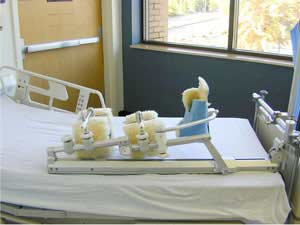Anatomy
Arthritis
Partial Knee Replacement
Total Knee Replacement
Less Invasive Total Knee
What to Expect on Surgery Day
Post Operative Care
Knee Rehabilitation
Non-Surgical Alternatives
Life After Knee Replacement
Sometimes a knee replacement is the only option for reducing pain and restoring a normal activity level. If your doctor decides that knee surgery is right for you, here is an idea of what to expect during days leading up to and the day of your surgery.
Pre-surgery Routines
Once you and your orthopaedic surgeon have decided to proceed with knee replacement surgery, there are several activities that must occur to help make sure all goes well.
First you will have your initial surgical consultation, which will include preoperative X-rays, a complete past medical history, a complete past surgical history and a complete list of all medications and allergies. This consultation will also include orthopaedic examination and discussion of the knee replacement surgery procedure.
Next you will have a complete physical examination. Your internist or family physician will determine if you are in the best possible condition to undergo knee surgery.
You may wish to donate blood prior to your knee replacement surgery in the event that a transfusion is required after surgery.
Your doctor may recommend that you see a physical therapist before surgery to learn exercises to begin prior to surgery. You will also get an overview of the rehabilitation process after knee replacement surgery. This will prepare you better for your post-operative care.
Preparation for the Hospital
You may want to bring the following items to the hospital for your knee replacement surgery:
- Clothing: underwear, socks, t-shirts, exercise shorts for rehabilitation
- Footwear: walking or tennis shoes for rehab; slippers for hospital room
- Walking aids: walker, cane, wheelchair, or crutches if used prior to surgery
- Insurance information
Preoperative Procedures
On the morning of your knee replacement surgery you will be admitted to the hospital. Your vital signs will be taken, you’ll be given a clean hospital gown to wear during the procedure, and an IV will be started to give you fluids and medication during and after the procedure.
You may be provided an elastic stocking to decrease the likelihood of blood clots. You will be asked to empty your bladder. All jewelry, dentures, contacts, and nail polish must be removed. The surgical leg will be scrubbed and shaved in preparation for surgery. The anesthesiologist will come into your room and discuss the type of anesthesia that will be used. Finally, you will be taken into the operating room.
Surgery and Recovery
A total knee replacement involves cutting away the damaged bone of the knee joint and replacing it with a prosthesis. You will be under anesthesia during the procedure.
After your surgery is completed, you will be transported to the recovery room for close observation of your vital signs, circulation, and sensation in your legs and feet. As soon as you awaken and your condition is stabilized, you will be transferred to your room.
When you wake up you will find a bulky dressing applied to your incision in order to maintain cleanliness and absorb any fluid. There may be a drain placed near your incision in order to record the amount of fluid being lost from the wound.
Your doctor may prescribe a PCA device (patient-controlled analgesia) that is connected to your IV. The unit is set to deliver a small, controlled flow of pain medication and is activated when you firmly press the button on your machine. Press the button anytime you are having pain.
You may have a catheter inserted into your bladder as the side effects of anesthesia may make it difficult to urinate.
A continuous passive motion (CPM) unit may be placed on your leg to slowly and gently bend and straighten your knee. This device, if prescribed, is important for quickly regaining your knee range of motion.

Contents Courtesy of www.knee-replacement-info.com